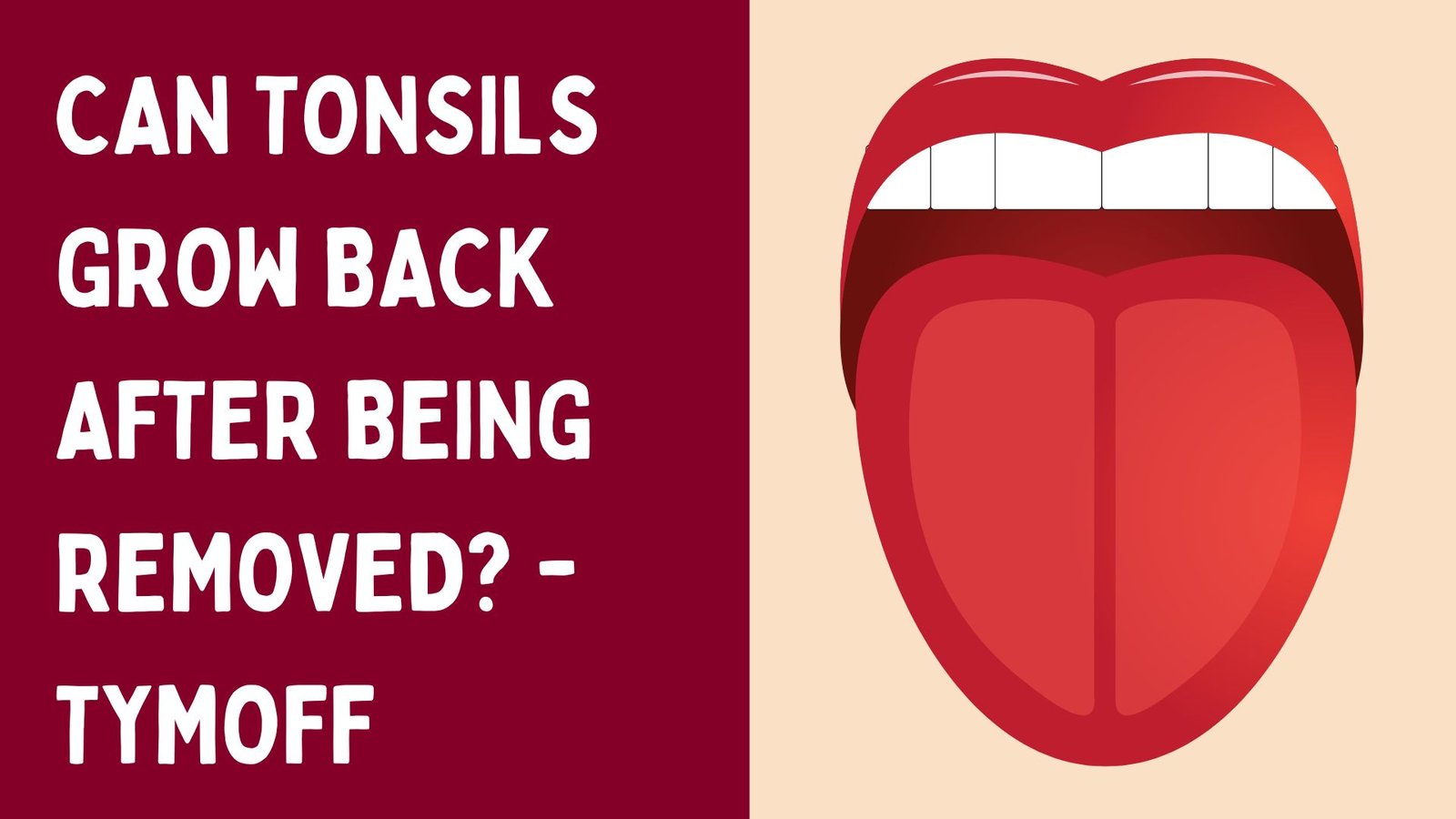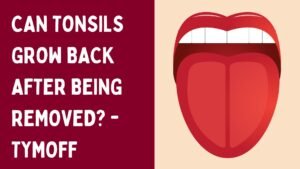Can Tonsils Grow Back After Being Removed? – Tymoff
Tonsillectomy is a common medical procedure that involves the surgical removal of the tonsils, which are located at the back of the throat. The procedure is typically performed to treat recurring infections, such as chronic tonsillitis, or to address issues like obstructive sleep apnea. After the tonsils are removed, many patients are left wondering whether their tonsils can grow back, especially if they experience similar symptoms to those that led to the removal in the first place. This article explores the question: Can tonsils grow back after being removed? and provides an informative and comprehensive look at this subject.
What Happens During a Tonsillectomy?
A tonsillectomy is performed under general anesthesia, meaning the patient is asleep and pain-free during the surgery. The surgeon removes the tonsils through the mouth, using specialized surgical tools. The procedure generally takes about 30 to 45 minutes. After the removal, the patient may experience discomfort or a sore throat, which is common in the recovery process.
The tonsils themselves are made up of lymphoid tissue and play a role in the body’s immune system by helping to filter out bacteria and viruses that enter through the mouth and nose. When these tissues become infected or enlarged, they can cause various health problems, including recurring infections, breathing difficulties, or difficulty swallowing. Tonsillectomy can provide relief from these issues, but the question remains: Can the tonsils grow back after being removed?
Also Read: The Correct Spelling Is School Not School. Some Pe – Tymoff
Can Tonsils Grow Back After Removal?
In most cases, the answer to the question can tonsils grow back after being removed is no, tonsils do not regenerate once they have been completely removed. During a tonsillectomy, the surgeon removes the tonsils entirely, and the body typically heals by forming scar tissue in the area where the tonsils once were. The removal is intended to be permanent, and the tissue that makes up the tonsils does not regrow.
However, there are certain conditions in which some remnants of tonsil tissue could potentially lead to the growth of new tissue. This is an extremely rare occurrence, and it is not the same as the tonsils fully growing back. Let’s take a closer look at this possibility.
The Rare Possibility of Tonsil Tissue Regrowth
While it’s very uncommon, some patients may experience regrowth of tonsil tissue after a tonsillectomy. This can occur if small fragments of tonsil tissue were left behind during the surgery. These fragments could potentially begin to grow again, although this is very rare. The regrowth of tonsil tissue typically doesn’t result in the complete return of the tonsils to their original size or function. In most cases, if regrowth occurs, it’s minimal and might not cause any significant symptoms.
In some situations, if regrowth does happen, it can lead to recurring symptoms similar to those experienced before the tonsillectomy, such as throat pain or inflammation. If this occurs, a follow-up visit to the doctor is essential, as they may recommend additional treatment or even a second surgery if necessary.
Why Might Tonsils Seem to Grow Back?
There are a few other reasons why some people might think their tonsils are growing back after being removed. One of the main causes of confusion is the presence of a condition known as residual tonsil tissue or tonsil remnants. These are small bits of tissue left behind during the tonsillectomy that may continue to cause inflammation or infection. In some cases, the tonsil remnants may become infected, leading to symptoms that mimic the original problem.
Additionally, the tonsils are part of a larger group of lymphoid tissues in the throat. After a tonsillectomy, other tissues, such as the adenoids or other lymphoid structures, may compensate for the loss of the tonsils and continue to perform immune system functions. This could lead to similar symptoms, which might be mistaken for regrowth of the tonsils.
Tonsillectomy Outcomes and Success Rate
The success rate of tonsillectomy is quite high. Most patients experience significant improvements in their health after the procedure. For individuals who suffered from chronic tonsillitis or frequent throat infections, the surgery can be life-changing. After the tonsils are removed, patients generally experience fewer infections and less discomfort in the throat area. In fact, many people find relief from issues like sleep apnea, as the removal of the tonsils can sometimes open up the airway and improve breathing during sleep.
However, as with any surgery, there are risks involved. Complications from a tonsillectomy can include bleeding, infection, or adverse reactions to anesthesia. The recovery period can also be uncomfortable, with pain in the throat that may last for several days or even weeks. Although regrowth of tonsil tissue is rare, it is still important for patients to monitor their symptoms and seek medical advice if they suspect any issues.
When Should You Worry About Symptoms After a Tonsillectomy?
If you’ve had a tonsillectomy and start to experience symptoms similar to those you had before the surgery, it’s important not to panic. While it’s unlikely that your tonsils have grown back, it’s possible that other issues, such as tonsil tissue remnants, infections, or even other underlying conditions, are at play.
Here are some symptoms that may indicate you should consult with a doctor:
- Persistent Sore Throat: If you experience a sore throat that lasts longer than expected or worsens over time, it may indicate a problem that needs further investigation.
- Swollen Glands: Swelling in the neck or under the jaw could signal an infection or other issue related to the lymphatic system.
- Frequent Infections: If you continue to experience frequent throat infections, it could indicate that the tonsil remnants are still causing problems or that other lymphoid tissues are being affected.
- Difficulty Breathing or Swallowing: Any new or recurring difficulty with breathing or swallowing after surgery should be evaluated by a healthcare professional.
Also Read: Meet the Iconic Couple from the Woodstock Album Co – Tymoff
Alternatives to Tonsillectomy
For patients who are concerned about the possibility of tonsil regrowth or those who experience recurring symptoms after the procedure, there are alternative treatments to consider. Some options include:
- Antibiotics: If the issue is related to a bacterial infection, antibiotics may help to resolve the problem.
- Steroid Treatment: For inflammation of the throat or residual tonsil tissue, steroids might be prescribed to reduce swelling and pain.
- Adenoidectomy: In some cases, the adenoids, which are similar to tonsils, might also be removed if they are causing similar issues. This is often performed in conjunction with tonsillectomy in younger children.
Final Thoughts on Tonsil Regrowth
In conclusion, while it is very rare for tonsils to grow back after being removed, the possibility does exist if small amounts of tissue were left behind during the surgery. In most cases, tonsillectomies are successful and permanent, providing significant relief from conditions like chronic tonsillitis or sleep apnea. If you experience symptoms similar to those before your tonsillectomy, it’s important to consult with your healthcare provider to determine the cause and explore potential treatment options. The key takeaway is that tonsils generally do not grow back, and any perceived regrowth is usually due to other factors such as residual tissue or related health issues.
If you are considering a tonsillectomy or have concerns about your post-surgery recovery, it is always best to consult with your doctor, who can offer personalized advice and guidance based on your unique medical history and needs.









Post Comment